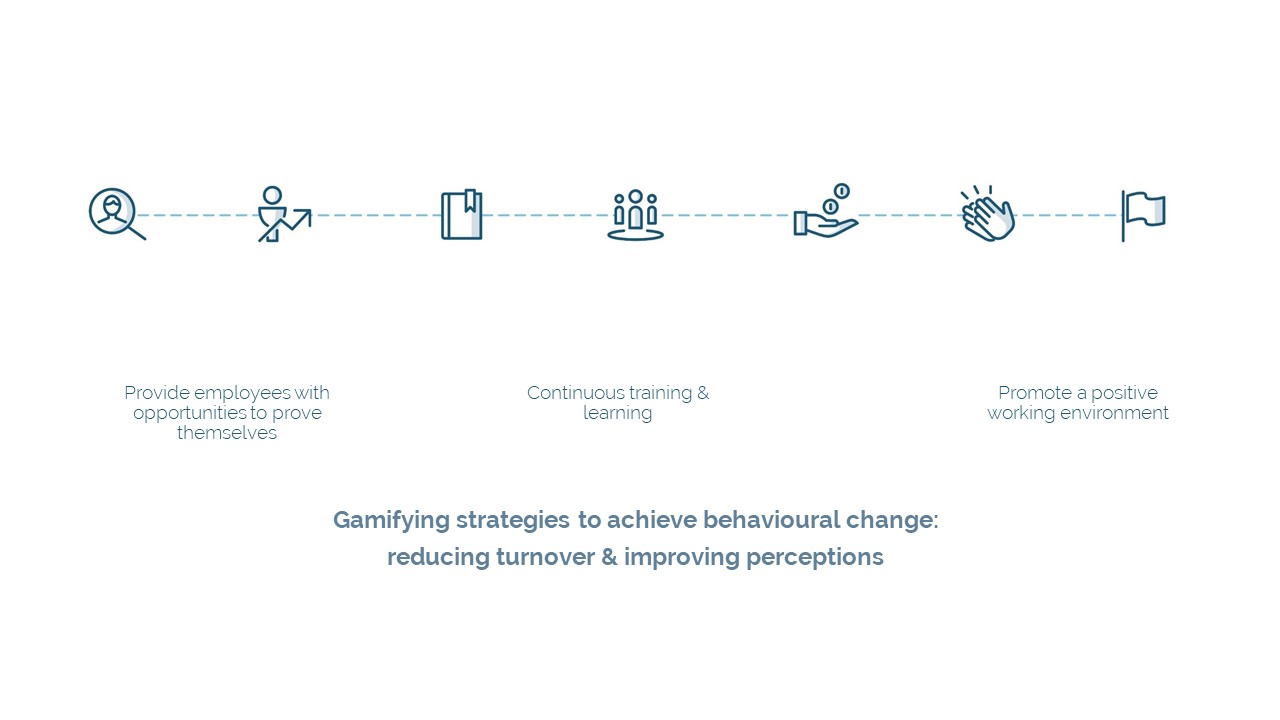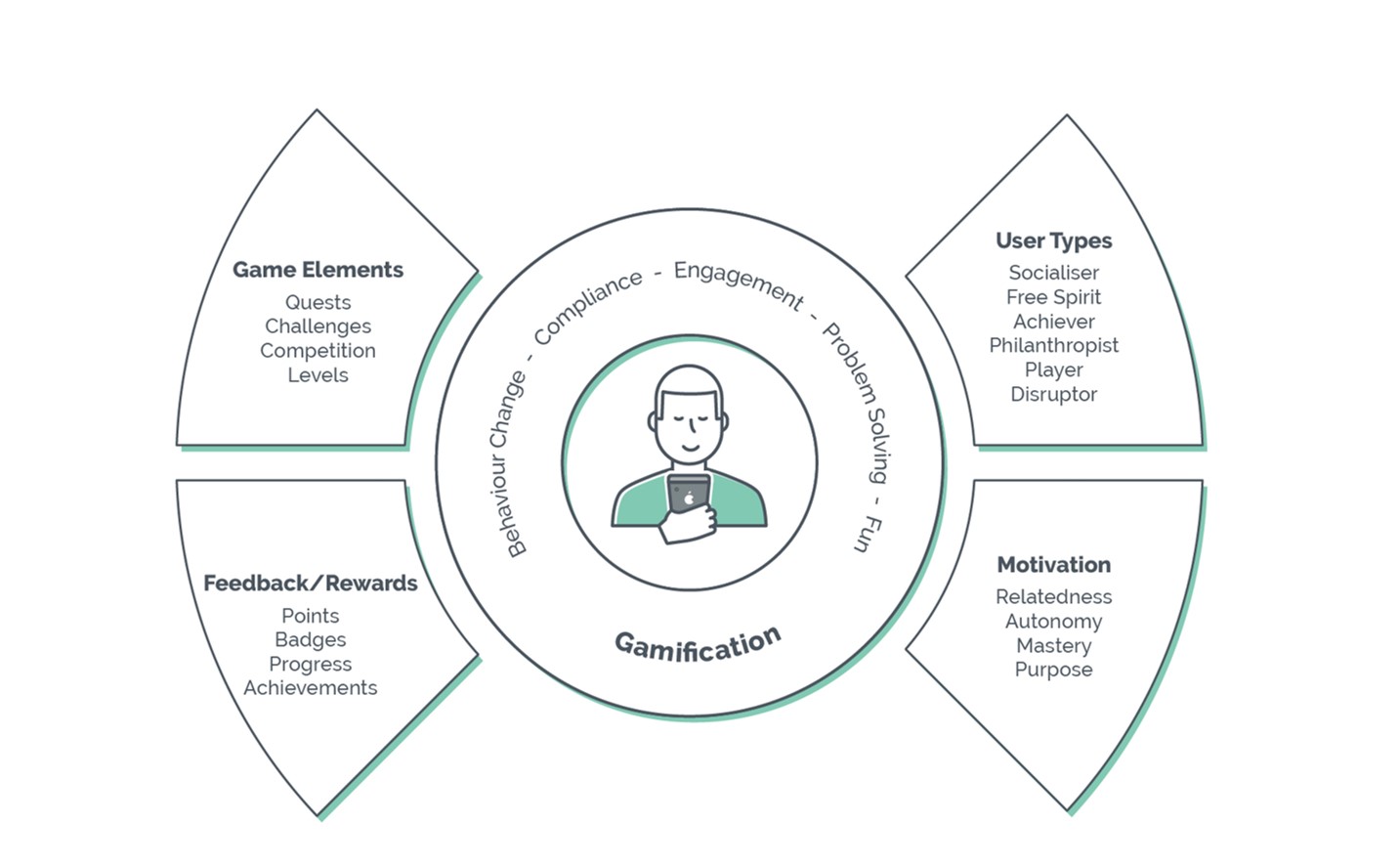The art of designing attractive and effective digital engagement solutions
Are the rules of reality broken? We have become used to dividing areas or putting things in their specific boxes. Work is serious. Games are fun. Learning is serious. Creativity is fun. Problem solving – serious or fun? When we dive into the world of game thinking or game design, often grouped together under the term of Gamification, the well-defined barrier between serious contexts and play falls away. Why apply game elements to traditionally serious contexts? To get the most out of all aspects of life, sometimes we need to add more play!
Now, reality can be much more attractive and entertaining thanks to “Serious Play Experiences”.
“Serious Play Experiences”, are situations where fun narratives and game elements can be introduced without losing sight of the serious objectives driving them (for example: incentivising recycling across communities, reducing employee turnover, sustaining interest in learning materials). Often because of the serious nature of such contexts, applying fun elements can significantly enhance motivation, commitment and participation – resulting in a successful achievement of objectives.
Doesn’t sound like something you’d use? You might be surprised, as there are more examples out there than you probably think.
Mixed serious gaming experiences, not just digital
By adding face-to-face challenges, the experience can help to build social relationships or interpersonal skills in the process. This can be seen in educational contexts/scenarios, where the “escape room” concept has been adapted to provide a fun yet educational classroom learning experience. For example, Breakout Edu where as well as having an immersive game platform, players also have to work face-to-face collaboratively to solve a series of critical thinking puzzles to open a locked box. These experiences rely on a very collaborative narrative plot. When this dynamic is replicated within a digital context, the solution can include multiple communication channels and a virtual social area that further increases the feeling of community and positive group identity.
Serious gaming experiences in virtual reality environments
This is one of the most prominent emerging trends in Serious Play Experiences in the last few years. Virtual reality offers infinite possibilities due to its great versatility. A lot of use can be seen within training contexts, both educational and corporate, especially where very specific training or practice is required (such as unconscious bias training for example).
From a gamification point of view, virtual reality reinforces the weight of game elements such as avatars and non-linear or open plot narration, substantially improving users sense of freedom.
Are you interested in gamification?
Gaming experiences in augmented reality environments
Many examples are also appearing in the market of this type of initiative. To name a few: “Zombie Run”, “Ring fit” and “Peloton”. These experiences rely on a mission structure. Each mission includes challenges that gradually increase the difficulty to increase participant’s sense of progress. To support this, other game elements are added such as the progress bar, badges and points, which reinforce the perception of autonomy and self-improvement.
So, how are serious contexts “seasoned” with the right amount of play, to ensure the objective is still met? And how could they work for you and your organisation? Let’s take a look at the solution-design steps required for taking users toward fulfilling objectives.
- User-centric analysis:
Before getting stuck in, it’s important to carry out a detailed analysis of the situation your target audience or objectives are operating within. You will need to understand information about the context and the users’ behaviours, characteristics, game preferences and digital skills, to be able to create a solution that will integrate easily into everyday life.
- Include effective components:
With client and user needs forming the foundations, you can next include the necessary components to build the actual journey or strategy of the solution. By basing or choosing components with an understanding of Behavioural Science, you can create a path that users will actually want to follow and that will feel intuitive to them. The different parts need to consider user characteristics and preferences (collected from the previous step) as well as client requirements. The aim of the game is of course to deliver results and achieve the determined objective, but this will only be successful if you provide an experience that people feel able to collaborate in.
- Integrate game elements:
Making people want to take part, rather than feel they have to is a powerful motivation. Here is where introducing gamification is useful. It is no secret that people do better at something when they enjoy the activity itself. Applying game elements to a mundane or even dreary process (imagine if compliance training could be enjoyable) does not mean you simply turn the experience into a game or lose all sense of seriousness. Elements can be discrete nudges or prompts, or recognition of a user’s progress, spurring them to stick with the process or activity, boosting their motivation and commitment. To ensure a more fulfilling, engaging experience, you’re ultimately looking to weave together three interconnecting gamified structures: the narrative, the challenges, and the energisers.
Following us so far? Let’s look at an example to see how it all comes to life.
A large hotel chain was looking to reduce its high staff turnover by implementing new corporate values and culture that would hopefully encourage commitment to the brand. They needed an effective vehicle to deliver the information in a way that would stick with the employees, engaging them in the workplace and reducing feelings of detachment.
Digital solutions, either web or mobile applications, are easily accessible to wide audiences and often help to set experiences outside of the ‘real world’. In a digital solution, participants feel they can attempt challenges, immerse themselves in situations, and progress without the pressure of a manager looking over their shoulders. This means you can provide environments that resemble real life, with fewer real-life stresses.
Digital solutions also help ensure the same information reaches all people in the same way, standardising and centralising processes – such as the hotel chain communicating the new corporate values and culture. With all employees receiving the same core message, the next step is to help employees engage with this content and ultimately embody it.
Here is where we could introduce a learning by doing strategy (or learning through play). First you plot what the strategy of the solution should overcome, with an understanding of what the users need. Feelings of detachment can be resolved through tapping into people’s need for mastery, purpose, and achievement. Presenting the disillusioned employees with the chance to prove themselves and feel they are improving, which in turn gives their managers the cue to recognise this improvement. The strategy helps employees feel that they contribute to the overall success of the company and their contribution is valued. So we can look at gamifying three core steps to the strategy: a) provide opportunities to overcome challenges and improve, b) provide content and materials for employees to learn from and train with, c) foster and promote a positive environment where good work is recognised and encouraged.

Next: how to get people involved. A narrative structure always helps to increase individual’s interest in participating. This can be achieved by introducing an appealing plot that will engage participants and encourage them to follow and commit to the process. In this example, the employees of the hotel could be invited to join a virtual hotel (call to action) as virtual staff, attending to visiting customers. They are presented with different scenarios and opportunities (challenges) where they have to demonstrate the new brand values and behaviours, earning virtual currency or levelling up when they successfully overcome their challenges.
Designing meaningful “Serious Gaming Experiences” that make an impact or drive change is a complex but rewarding process, requiring the designer to consider a multitude of perspectives in the process. All of the elements have to work in harmony with each other to create a balanced experience, that drive the desired results. If the experience is too much like a game or too removed from reality, the core message becomes diluted. When an experience doesn’t take the participant’s needs and motivations into consideration it runs the risk of turning people off from engaging. Daily life is full of distractions and examples of innovation at our fingertips. Is it crazy to consider people’s expectations and attention need more stimulation in the experiences you offer?
Like most aspects of life and learning, you will get more out of any solution if you add a little play!
Written in collaboration by Marta Calderero & Andrzej Marczewski



